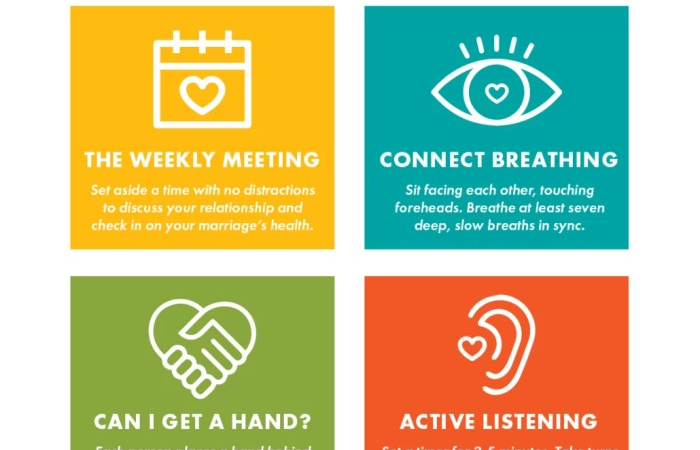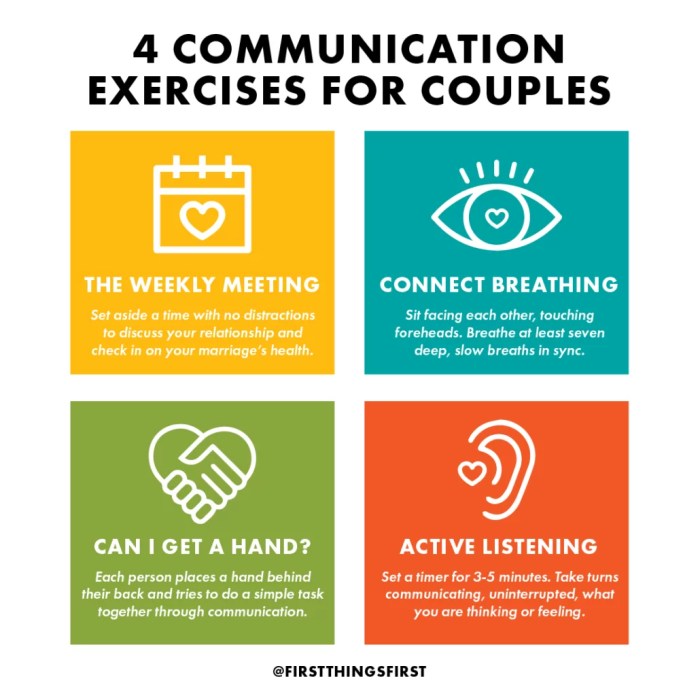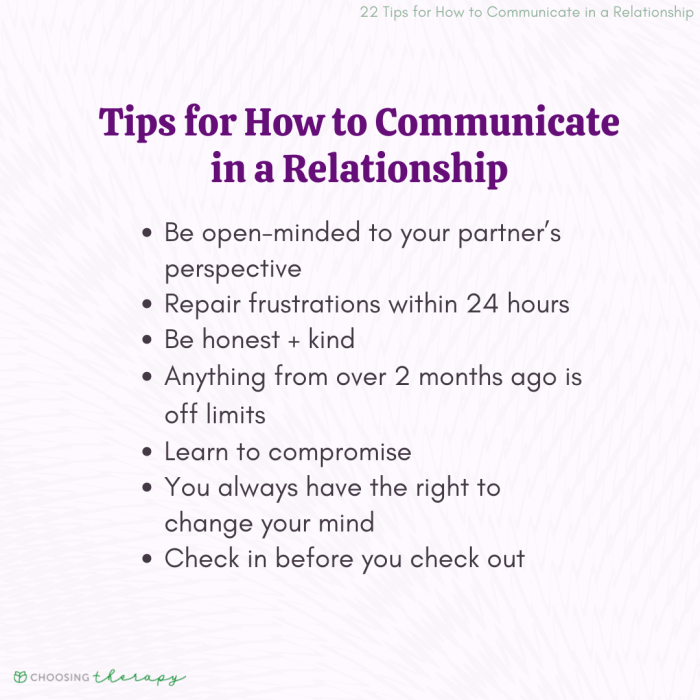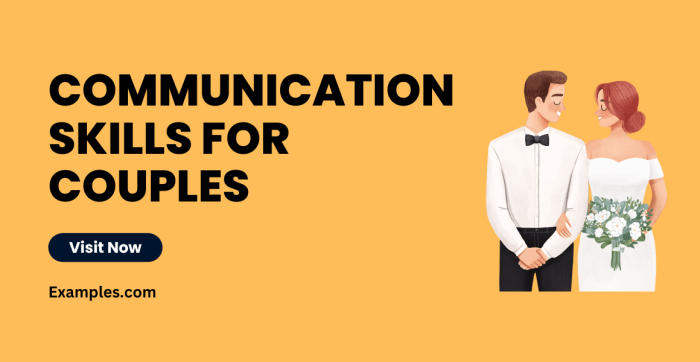Communication Skills for Couples: Building Stronger Bonds

Communication Skills for Couples: Building Stronger Bonds is a vital aspect of any healthy relationship. Effective communication is the foundation upon which trust, intimacy, and understanding are built. When couples learn to communicate effectively, they can navigate challenges, resolve conflicts, and deepen their connection in ways that strengthen their bond over time.
This guide explores various communication skills that couples can implement to enhance their relationship. From active listening and expressing needs to conflict resolution and navigating the digital age, each section provides valuable insights and practical strategies to foster open and meaningful communication.
Importance of Communication in Relationships
Communication is the lifeblood of any relationship, especially romantic ones. It is the foundation upon which trust, intimacy, and understanding are built. Effective communication allows couples to connect on a deeper level, navigate challenges together, and build a lasting bond.
Impact of Effective Communication on Relationships
Effective communication fosters a sense of security and connection in a relationship. When partners feel heard, understood, and respected, they are more likely to feel loved and valued. Open and honest communication allows couples to share their thoughts, feelings, and needs, leading to greater intimacy and emotional closeness.
- Enhanced Trust and Intimacy: When couples communicate openly and honestly, they build trust and strengthen their bond. This allows them to share vulnerabilities, resolve conflicts constructively, and create a safe space for emotional intimacy.
- Improved Conflict Resolution: Effective communication is essential for navigating disagreements and resolving conflicts. By expressing their perspectives clearly and listening actively to their partner’s point of view, couples can find solutions that work for both of them.
- Increased Understanding and Empathy: When couples communicate effectively, they gain a deeper understanding of each other’s thoughts, feelings, and perspectives. This leads to greater empathy and compassion, fostering a more harmonious and supportive relationship.
Impact of Poor Communication on Relationships
Poor communication can have a detrimental impact on a couple’s well-being. When partners fail to communicate effectively, it can lead to misunderstandings, resentment, and a breakdown in trust.
- Misunderstandings and Conflicts: Lack of clear communication can lead to misinterpretations, assumptions, and unresolved conflicts. This can create a cycle of negativity and resentment, damaging the relationship.
- Emotional Distance and Isolation: Poor communication can create a sense of emotional distance and isolation between partners. When couples are unable to express their feelings or connect on an emotional level, they may feel disconnected and lonely.
- Increased Stress and Anxiety: Unresolved conflicts and communication breakdowns can lead to increased stress and anxiety for both partners. This can negatively impact their overall well-being and create a toxic environment in the relationship.
Examples of Communication in Conflict Resolution
Communication plays a vital role in resolving conflicts effectively. By employing active listening, empathy, and clear articulation, couples can navigate disagreements constructively and reach mutually acceptable solutions.
- Active Listening: When one partner is expressing their concerns, the other should actively listen, paying attention to their words, tone, and body language. This demonstrates respect and understanding, creating a safe space for open dialogue.
- Empathy and Validation: It is crucial to acknowledge and validate your partner’s feelings, even if you don’t agree with their perspective. By showing empathy, you demonstrate that you understand and care about their emotions.
- Clear and Assertive Communication: Express your own needs and perspectives clearly and assertively, using “I” statements to avoid blaming or accusing your partner. This allows for a more constructive and respectful exchange of ideas.
Active Listening Skills: Communication Skills For Couples
Active listening is a crucial communication skill in any relationship, especially in romantic partnerships. It involves not just hearing the words your partner speaks but also understanding their emotions, perspectives, and underlying messages. By actively listening, you demonstrate empathy, respect, and a genuine interest in your partner’s thoughts and feelings.
The Importance of Nonverbal Cues in Active Listening
Nonverbal cues play a significant role in communication, conveying emotions and intentions that words alone may not express. Active listening involves paying attention to these nonverbal signals, as they can provide valuable insights into your partner’s true feelings and understanding.
- Body Language: Observe your partner’s posture, gestures, and facial expressions. Crossed arms or a slumped posture may indicate defensiveness or disinterest, while a relaxed stance and open gestures suggest receptiveness.
- Eye Contact: Maintaining appropriate eye contact shows attentiveness and engagement. However, excessive eye contact can be perceived as aggressive, while avoiding eye contact altogether might suggest disinterest or discomfort.
- Tone of Voice: Pay attention to the pitch, volume, and speed of your partner’s voice. A high-pitched voice might indicate anxiety, while a low, monotone voice could suggest boredom or apathy.
Scenario of Active Listening in a Relationship
Imagine a couple, Sarah and John, having a conversation about their upcoming vacation plans. Sarah is excited about visiting a bustling city, while John prefers a quiet beach getaway.
- Sarah: “I’m so excited about our trip! I’ve been researching all these amazing museums and restaurants in the city. We can spend our days exploring and enjoying the vibrant nightlife.”
- John: (with a slight frown) “I don’t know, Sarah. I’m not really into crowds or loud places. I’d prefer a more relaxing vacation where we can just unwind and enjoy the beach.”
- Sarah: (noticing John’s frown) “Oh, you’re right. I didn’t realize how much you were looking forward to a relaxing trip. I’m sorry, I got carried away with my plans.”
- John: “It’s okay, Sarah. I appreciate you sharing your excitement. Maybe we can find a compromise where we can both enjoy ourselves. How about we spend a few days in the city and then head to the beach for some relaxation?”
- Sarah: “That sounds perfect! We can both have some fun and still get that much-needed break.”
In this scenario, Sarah actively listens to John’s concerns, acknowledging his frown and his preference for a quiet vacation. She refrains from getting defensive and instead focuses on understanding his perspective. John, in turn, appreciates Sarah’s attentiveness and expresses his own needs, leading to a compromise that satisfies both of them.
Expressing Needs and Feelings
Effective communication in relationships goes beyond simply exchanging information; it involves expressing needs and feelings openly and honestly. This allows couples to understand each other better, build trust, and resolve conflicts constructively.
Communicating Needs and Feelings Clearly and Respectfully
Clear and respectful communication is crucial for expressing needs and feelings effectively. When communicating, it’s important to focus on your feelings and needs without blaming or attacking your partner.
- Use “I” Statements: “I” statements help you express your feelings and needs without placing blame on your partner. For example, instead of saying “You always forget to take out the trash,” try “I feel frustrated when the trash isn’t taken out, as it makes the house feel messy.”
- Be Specific: Avoid vague statements like “You never listen to me.” Instead, provide specific examples of what happened and how it made you feel. For example, “When you interrupted me while I was talking about my work project, I felt disrespected and unheard.”
- Choose the Right Time and Place: Avoid bringing up sensitive topics when you’re both stressed or tired. Find a time when you can both focus on the conversation and be receptive to each other’s perspectives.
- Focus on Solutions: After expressing your needs and feelings, focus on finding solutions together. This can involve brainstorming ideas or discussing compromises.
Using “I” Statements
“I” statements are a powerful tool for assertive communication. They allow you to express your feelings and needs without accusing or blaming your partner.
“I feel emotion when situation/behavior because reason.”
For example:
“I feel frustrated when you leave your dirty dishes in the sink because it makes me feel like I’m doing all the housework.”
Assertive Communication Techniques
Assertive communication involves expressing your needs and feelings clearly and respectfully, while also respecting your partner’s point of view. Here are some techniques:
- Active Listening: Pay attention to what your partner is saying, both verbally and nonverbally. Use verbal cues like “I understand” or “Tell me more” to show that you’re listening.
- Empathy: Try to understand your partner’s perspective, even if you don’t agree with it. This can help you find common ground and build a stronger connection.
- Negotiation: Be willing to compromise and find solutions that work for both of you. This can involve finding creative solutions or making concessions.
- Setting Boundaries: Communicate your limits clearly and respectfully. For example, “I need some time to myself after work, so I’d appreciate it if you wouldn’t interrupt me during that time.”
Conflict Resolution Strategies
Conflict is a natural part of any relationship, and it’s how couples handle disagreements that determines the health and longevity of their bond. Effective conflict resolution skills are essential for navigating these inevitable bumps in the road and fostering a stronger, more fulfilling partnership.
Understanding Different Conflict Resolution Approaches
Different approaches to conflict resolution can be categorized based on their focus on assertiveness and cooperation. These approaches can be represented on a spectrum, with some strategies leaning towards assertiveness and others towards cooperation.
- Avoiding: This approach involves withdrawing from the conflict, minimizing engagement, and hoping it will resolve itself. While it might seem peaceful in the short term, avoiding conflicts can lead to resentment and unresolved issues.
- Accommodating: This strategy prioritizes the needs and desires of the partner over one’s own. While it can maintain harmony in the moment, it can also lead to feelings of being taken advantage of and resentment building up over time.
- Competing: This approach is highly assertive and seeks to win at all costs, often at the expense of the partner’s needs. It can lead to feelings of anger, hostility, and damage to the relationship.
- Compromising: This approach involves finding a middle ground where both partners make concessions to reach a mutually acceptable solution. While it can be effective in finding a solution, it may not always address the underlying needs of both partners.
- Collaborating: This approach focuses on finding a solution that meets the needs of both partners. It requires open communication, active listening, and a willingness to work together. This approach often leads to the most satisfying and sustainable solutions.
Using Compromise and Negotiation to Find Solutions
Compromise and negotiation are valuable tools in conflict resolution. They allow couples to find solutions that are acceptable to both partners, even if they don’t perfectly align with their initial preferences.
- Identify the Underlying Needs: Before engaging in compromise, it’s essential to understand the underlying needs driving each partner’s position. For example, a disagreement about household chores might stem from a need for fairness, autonomy, or appreciation.
- Seek Common Ground: Once the underlying needs are understood, focus on finding common ground. Look for areas where both partners share similar goals or values, and build upon those areas to find a solution.
- Be Willing to Make Concessions: Compromise requires both partners to be willing to give something up to reach a mutually acceptable solution. This can involve adjusting expectations, finding alternative solutions, or agreeing on a timeframe for implementation.
- Negotiate in Good Faith: Negotiations should be conducted with a focus on finding a solution that works for both partners. Avoid using manipulation, threats, or ultimatums, as these tactics can damage the relationship.
Effective Strategies for Resolving Conflicts in a Healthy Manner
- Communicate Effectively: Clear and respectful communication is crucial for resolving conflicts. Express your needs and feelings clearly, and listen attentively to your partner’s perspective. Avoid blaming, name-calling, or attacking each other.
- Take Breaks When Needed: If emotions are running high, take a break from the conversation to cool down. This allows both partners to regain their composure and approach the discussion with a calmer mindset.
- Focus on Solutions, Not Blame: Instead of dwelling on who is right or wrong, focus on finding solutions that address the underlying issues. This shifts the conversation from blame to problem-solving.
- Be Willing to Forgive: Holding onto resentment and anger will only perpetuate the conflict. Be willing to forgive each other, even if it’s difficult, to move forward.
- Seek Professional Help If Needed: If you find yourselves struggling to resolve conflicts on your own, consider seeking professional help from a couples therapist. They can provide guidance and support in navigating disagreements and building healthier communication patterns.
Maintaining Open Communication

Open communication is the lifeblood of any healthy relationship. It’s not just about talking; it’s about actively listening, understanding each other’s perspectives, and creating a safe space for vulnerability and honesty.
Daily Habits for Open Communication
Maintaining open communication requires consistent effort. Here are some daily habits that can help cultivate a more open and understanding relationship:
- Start the Day with a Check-In: Even a brief conversation about each other’s plans for the day or a shared moment of appreciation can set a positive tone for the day.
- Schedule Dedicated Time for Communication: Set aside regular time, even if it’s just 15-20 minutes each day, to talk about your thoughts, feelings, and experiences. This dedicated time can help you prioritize communication and avoid distractions.
- Practice Active Listening: When your partner is talking, put away distractions, make eye contact, and truly listen to what they are saying. Ask clarifying questions and reflect on their feelings to show that you are engaged.
- Express Appreciation: Make an effort to express your appreciation for your partner, both big and small. This can be through words, gestures, or acts of service.
- Share Your Day: Even if it’s just a brief recap of your day, sharing your experiences can help your partner feel connected to you and understand your perspective.
- Be Open to Feedback: Be willing to hear your partner’s feedback, even if it’s not always easy to hear. It shows that you value their opinion and are committed to improving your communication.
- Avoid Making Assumptions: Instead of assuming you know what your partner is thinking or feeling, ask clarifying questions to ensure you understand their perspective.
Communication Styles and Their Impact, Communication skills for couples
Different people have different communication styles. Understanding your own and your partner’s communication styles can help you navigate potential misunderstandings and strengthen your communication. Here’s a table outlining common communication styles and their impact on relationships:
| Communication Style | Description | Impact on Relationships |
|---|---|---|
| Assertive | Expressing needs and opinions clearly and respectfully, while also respecting the other person’s boundaries. | Promotes healthy boundaries, clear understanding, and mutual respect. |
| Passive | Avoiding expressing needs or opinions, often leads to resentment and frustration. | Can lead to misunderstandings, bottled-up emotions, and resentment. |
| Aggressive | Expressing needs and opinions in a forceful or demanding manner, often disrespecting the other person’s boundaries. | Can damage relationships, create conflict, and erode trust. |
| Passive-Aggressive | Expressing needs and opinions indirectly, often through sarcasm or subtle manipulation. | This can lead to confusion, hurt feelings, and a lack of trust. |
Regular Check-Ins and Dedicated Time for Communication
Regular check-ins and dedicated time for communication are essential for maintaining open and healthy relationships. These can be brief, casual conversations or more structured discussions, depending on your needs and preferences.
- Daily Check-Ins: Even a few minutes each day can help you stay connected and aware of each other’s needs and emotions.
- Weekly Check-Ins: Set aside a specific time each week to discuss more in-depth topics, such as your goals, challenges, and aspirations.
- Monthly Check-Ins: Consider having a more formal check-in once a month to review your relationship, discuss any issues that have arisen, and celebrate your successes.
- Dedicated Time for Communication: In addition to regular check-ins, it’s important to create dedicated time for quality communication. This could be a date night, a walk in the park, or simply relaxing on the couch together. The key is to be present, engaged, and focused on each other.
Understanding Different Communication Styles

Everyone communicates differently, and understanding these styles is crucial for effective communication in relationships. Recognizing your partner’s communication style and adapting your own can significantly improve your understanding and connection.
Identifying Common Communication Styles
Communication styles are influenced by various factors, including personality, upbringing, and cultural background. Understanding these styles helps identify potential communication challenges and find solutions. Here are some common communication styles:
- Assertive: Assertive communicators express their needs and feelings clearly and directly while respecting the opinions and feelings of others. They use “I” statements and focus on finding solutions that work for everyone.
- Passive: Passive communicators often avoid expressing their needs and feelings, fearing conflict or disapproval. They may agree with others even if they disagree, leading to resentment and frustration.
- Aggressive: Aggressive communicators prioritize their own needs and feelings, often disregarding the feelings of others. They use blaming, interrupting, and harsh language, leading to tension and conflict.
- Passive-Aggressive: Passive-aggressive communicators express their anger or frustration indirectly, often through sarcasm, manipulation, or withholding information. This style can lead to misunderstandings and strained relationships.
Comparing and Contrasting Communication Styles of Different Partners
Couples often have different communication styles, which can lead to misunderstandings and conflict. For example, a partner who is assertive might be frustrated by a partner who is passive, while a partner who is aggressive might be perceived as intimidating by a partner who is passive-aggressive.
It’s important to remember that there is no “right” or “wrong” communication style. The key is to understand each other’s styles and find ways to communicate effectively despite these differences.
Adapting Communication Styles
Adapting communication styles involves being flexible and understanding your partner’s needs. This requires active listening, empathy, and a willingness to compromise.
- Practice active listening: Pay attention to what your partner is saying, both verbally and nonverbally. Ask clarifying questions and reflect on their feelings to show that you understand.
- Use “I” statements: Express your feelings and needs without blaming your partner. For example, instead of saying “You always forget to take out the trash,” say “I feel frustrated when the trash isn’t taken out.”
- Validate your partner’s feelings: Even if you don’t agree with their perspective, acknowledge their feelings and try to understand their point of view.
- Find common ground: Focus on finding solutions that work for both of you, rather than trying to win an argument.
Communication in the Digital Age

The digital age has revolutionized the way we communicate, bringing both challenges and opportunities for couples. While technology offers numerous ways to stay connected, it also introduces new complexities that can impact relationships. Understanding these complexities and navigating the digital landscape effectively is crucial for maintaining healthy communication within a couple.
Navigating Communication Through Technology
Technology has significantly impacted how couples communicate, offering both advantages and disadvantages. The use of various platforms, including messaging apps, social media, and video calls, allows couples to stay connected even when physically apart. However, it also introduces new challenges, such as the potential for misinterpretations, misunderstandings, and the blurring of boundaries.
- Increased Accessibility: Technology provides couples with constant access to each other, facilitating frequent communication. This can be beneficial for staying connected and sharing updates, but it can also lead to over-reliance on technology for communication, neglecting face-to-face interactions.
- Nonverbal Cues: Text-based communication often lacks the nonverbal cues present in face-to-face interactions, which can lead to misunderstandings. Tone, facial expressions, and body language are crucial for conveying emotions accurately, and their absence in digital communication can lead to misinterpretations.
- Potential for Conflict: The constant accessibility of technology can create opportunities for misunderstandings and conflicts. A quick text or email can be misinterpreted, leading to arguments that could have been avoided with a face-to-face conversation.
Seeking Professional Help
Communication is a fundamental aspect of any relationship, and while most couples can navigate their differences, sometimes communication issues become deeply entrenched and difficult to resolve on their own. Seeking professional help from a relationship therapist can provide a safe and structured environment to address these challenges and improve communication patterns.
When to Seek Professional Help
Seeking professional help is a sign of strength and commitment to improving your relationship. Consider seeking professional guidance when:
- Communication patterns are consistently negative or destructive: This may involve frequent arguments, name-calling, defensiveness, or stonewalling.
- You’ve tried to resolve issues on your own but haven’t seen progress: If you’ve implemented communication strategies and haven’t seen positive changes, a therapist can offer fresh perspectives and tools.
- Communication breakdowns are affecting other areas of your lives: When communication issues spill over into work, family life, or overall well-being, it’s essential to seek professional support.
- You’re experiencing a significant life transition or challenge: Major events like marriage, parenthood, or career changes can strain communication and require external guidance.
- You’re feeling emotionally distant or disconnected from your partner: If you’ve lost the ability to connect emotionally or share your thoughts and feelings openly, seeking professional help can be beneficial.
Finding a Qualified Relationship Therapist
Finding a qualified relationship therapist is crucial for effective communication improvement. Here are some strategies:
- Seek recommendations from trusted sources: Ask friends, family members, or your primary care physician for referrals to therapists specializing in couples counseling.
- Utilize online directories: Websites like Psychology Today and the American Association for Marriage and Family Therapy (AAMFT) offer searchable directories of licensed therapists.
- Consider your preferences: Choose a therapist who aligns with your values and communication style. Some therapists specialize in specific approaches, such as Gottman Method Therapy or Emotionally Focused Therapy.
- Schedule a consultation: Most therapists offer free consultations to allow you to meet them and discuss your needs before committing to therapy.
Benefits of Couples Therapy
Couples therapy offers numerous benefits for improving communication skills and strengthening relationships:
- Provides a safe and structured environment for communication: Therapy offers a neutral space where couples can express their thoughts and feelings without judgment or interruption.
- Offers tools and strategies for effective communication: Therapists provide evidence-based techniques for active listening, expressing needs, and resolving conflicts constructively.
- Identifies communication patterns and underlying issues: Therapy helps couples understand the root causes of communication breakdowns and develop strategies to address them.
- Improves emotional connection and intimacy: By fostering open and honest communication, couples therapy can enhance emotional closeness and intimacy.
- Strengthens the relationship and promotes growth: Couples therapy provides a framework for couples to learn, grow, and build a more fulfilling relationship.
Last Word
Mastering communication skills is an ongoing journey for couples. By embracing open communication, active listening, and a willingness to understand each other’s perspectives, couples can create a foundation for a fulfilling and lasting relationship. Remember, communication is a two-way street, and both partners play a crucial role in creating a safe and supportive space for sharing thoughts, feelings, and dreams.
Comments are closed.